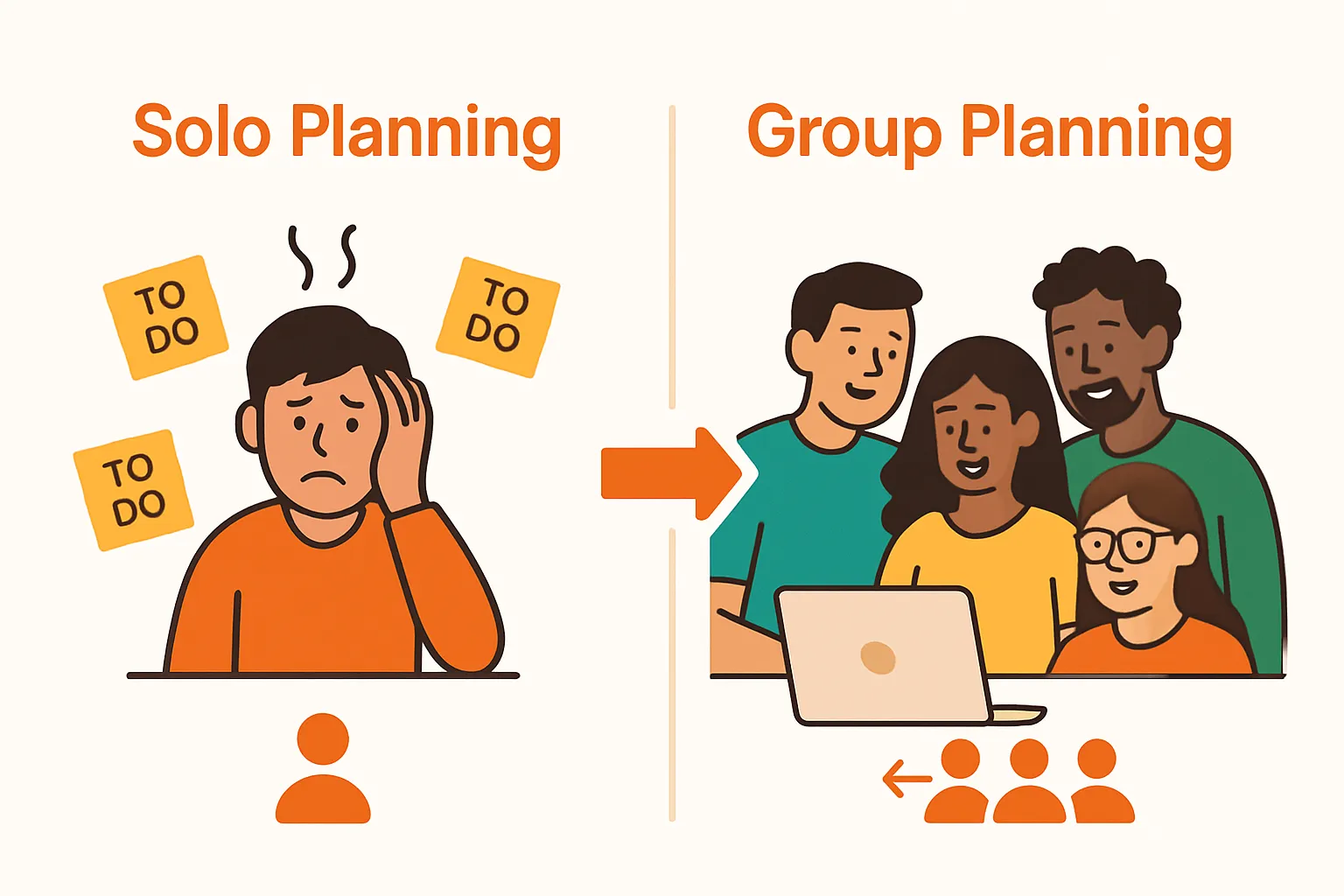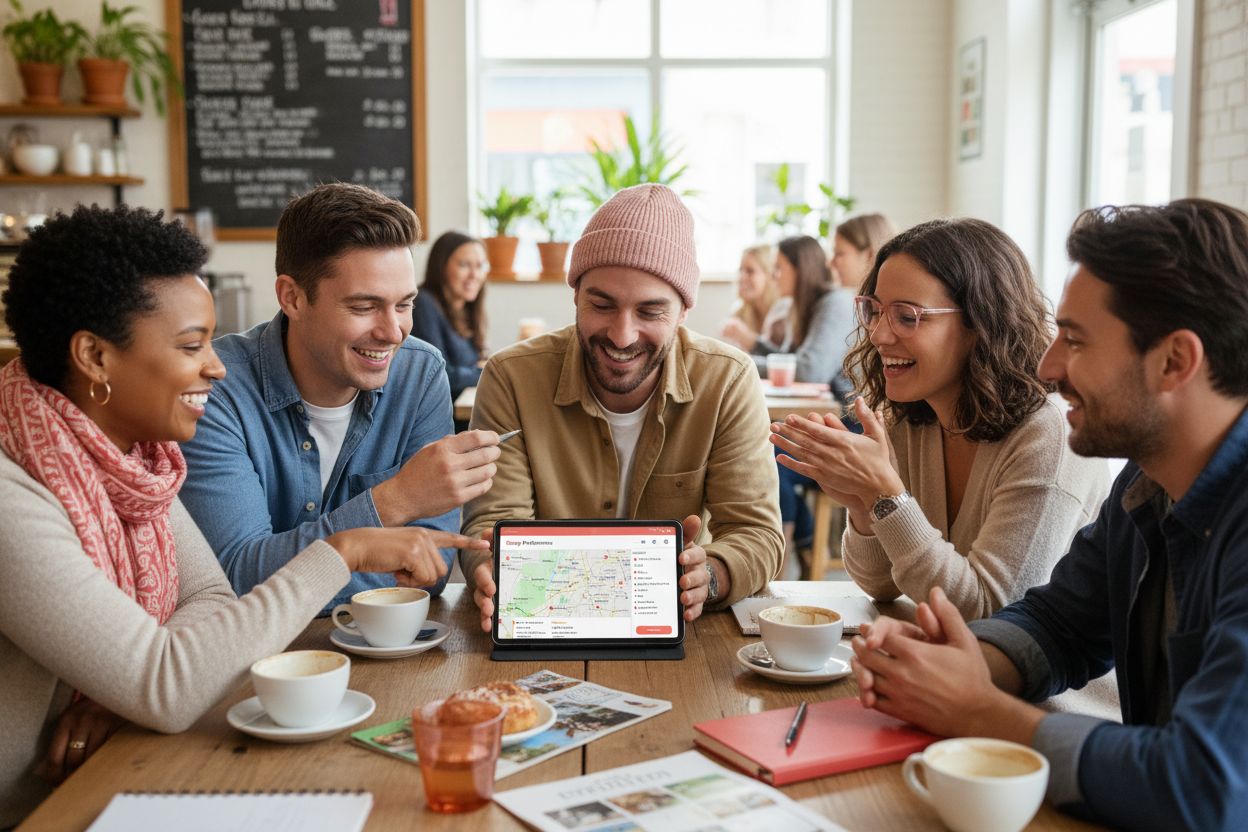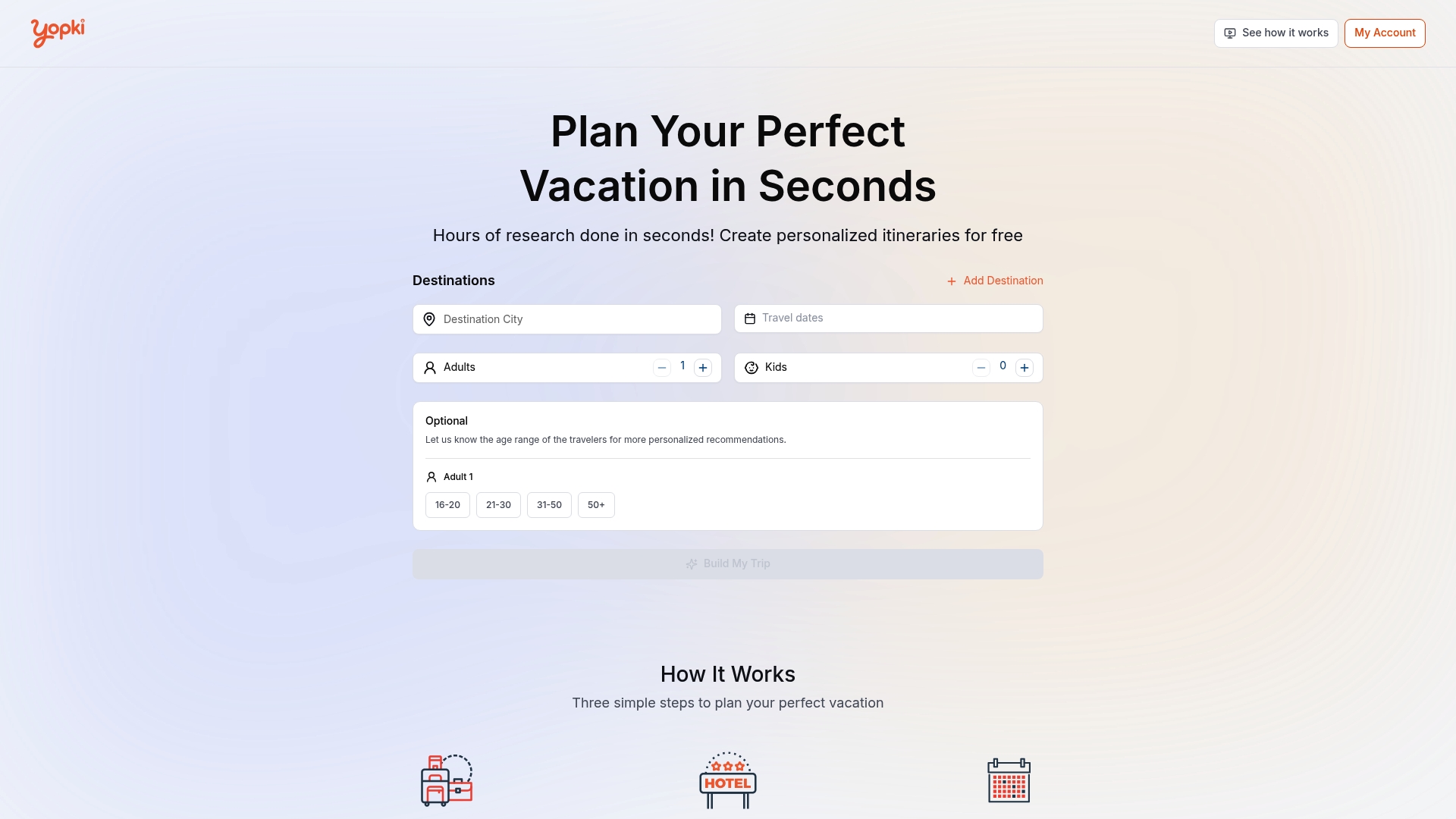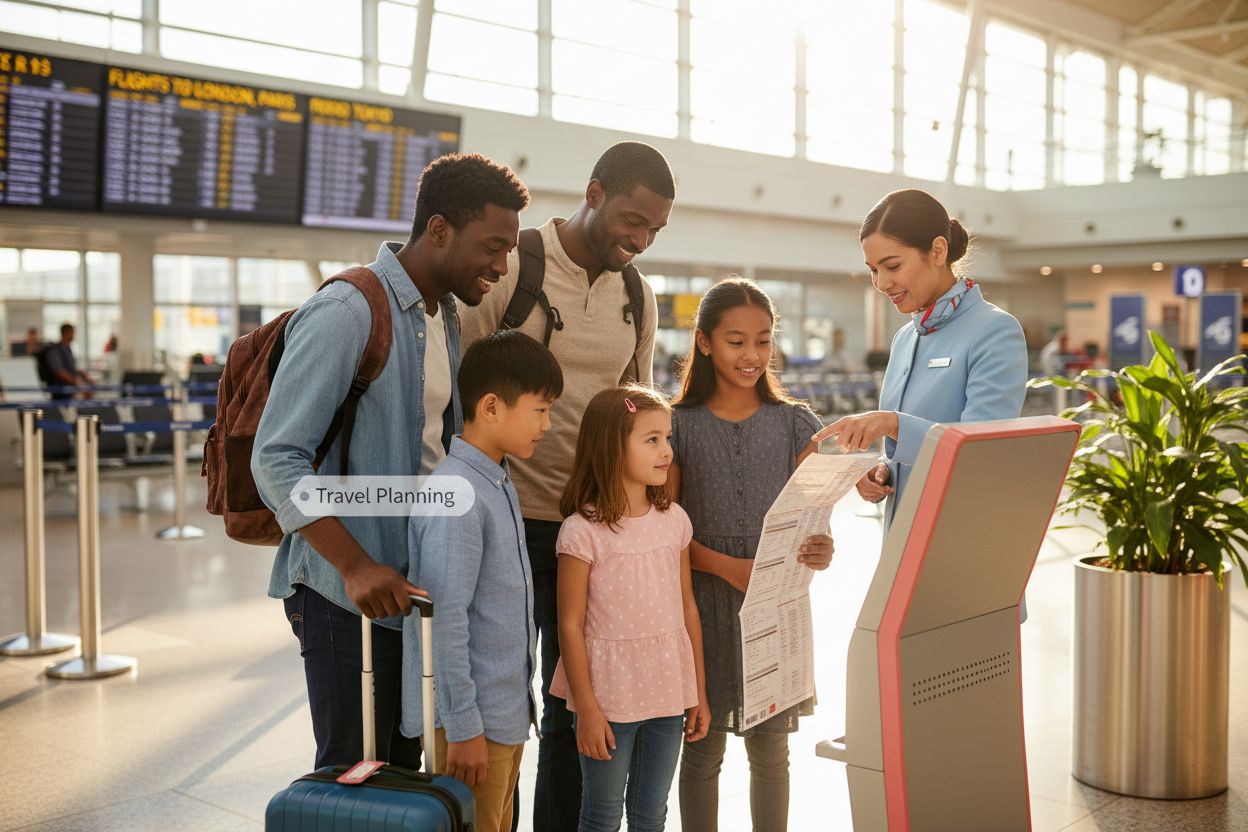Planning a group trip used to mean endless email chains and one person doing all the heavy lifting, but not anymore. Now, over 80 percent of people use digital platforms to plan trips together in real time. Most assume these platforms just make things faster and simpler, yet the biggest impact is actually deeper connections and more meaningful shared experiences before the journey even begins.
Table of Contents
- Understanding The Concept Of Collaborative Trip Planning
- The Importance Of Collaboration In Travel Planning
- Key Features Of Collaborative Trip Planning
- How Modern Technology Facilitates Trip Collaboration
- Real-World Applications Of Collaborative Trip Planning
Quick Summary
| Takeaway | Explanation |
|---|---|
| Collaborative trip planning enhances group dynamics. | Engaging multiple travelers improves consensus and satisfaction, reducing potential conflicts during planning. |
| Technology simplifies collaborative travel preparation. | Digital platforms offer tools for real-time coordination, making the planning process more engaging and efficient. |
| Pooling resources maximizes travel opportunities. | Groups can share financial resources and insider knowledge, resulting in reduced costs and better experiences. |
| Collective decision-making creates personalized itineraries. | By integrating preferences from all participants, the resulting plans are more tailored and enjoyable for everyone involved. |
| Real-time tools ensure seamless communication. | Cloud-based platforms facilitate immediate collaboration, enabling travelers to work together regardless of location. |
Understanding the Concept of Collaborative Trip Planning
Collaborative trip planning represents a modern approach to travel organization that transforms traditional solo planning methods into a shared, interactive experience. Research from digital interaction studies demonstrates this approach enables groups to collectively design travel experiences through technology-driven platforms.
The Core Principles of Collaborative Planning
At its essence, collaborative trip planning involves multiple individuals working together to design, refine, and finalize travel arrangements. This approach differs fundamentally from individual trip planning by introducing collective decision making and shared responsibilities.
 Key characteristics include:
Key characteristics include:
- Simultaneous input from multiple travelers
- Real time communication and feedback
- Transparent preference sharing
- Democratic decision making process
How Collaborative Trip Planning Works
The mechanism of collaborative trip planning typically involves digital platforms that allow participants to contribute preferences, vote on potential destinations, share budget considerations, and collectively build an itinerary. These platforms provide tools for:
- Synchronous editing of travel plans
- Voting on destination options
- Tracking individual and group preferences
- Managing shared budgets and expenses
By leveraging technology, collaborative trip planning transforms travel preparation from a potentially stressful individual task into an engaging group activity.
Read more about how trip visualization can enhance this process.
Ultimately, collaborative trip planning reflects broader trends in digital interaction where technology enables more connected, participatory experiences across various life domains.
The Importance of Collaboration in Travel Planning
Collaborative travel planning has emerged as a critical strategy for creating more meaningful, enjoyable, and efficient travel experiences. Research on group travel dynamics indicates that collaborative approaches significantly enhance overall trip satisfaction and reduce planning stress.
Enhancing Group Dynamics and Satisfaction
Collaboration transforms travel planning from a potentially challenging task into an inclusive, engaging process. When multiple travelers contribute their perspectives, preferences, and insights, the resulting itinerary becomes more comprehensive and balanced. Key benefits include:
- Reduced individual planning burden
- More diverse and comprehensive travel experiences
- Improved group consensus and satisfaction
- Minimized potential conflicts during trip preparation
Practical Benefits of Collaborative Planning
Beyond emotional and social advantages, collaborative trip planning offers tangible practical benefits. Groups can leverage collective resources, knowledge, and networks to make more informed decisions, potentially reducing costs and maximizing travel opportunities. This approach allows travelers to:
- Pool financial resources more effectively
- Share insider knowledge and travel tips
- Distribute planning responsibilities
- Create more personalized and adaptive travel experiences
By embracing collaborative strategies, travelers can transform trip planning from a potential source of stress into an exciting, shared journey of discovery. Learn more about optimizing your trip organization.
Ultimately, collaborative trip planning represents more than a method of preparation—it’s a holistic approach to creating shared memories and experiences that resonate long after the journey concludes.

Key Features of Collaborative Trip Planning
Research on digital travel platforms reveals that collaborative trip planning is distinguished by sophisticated technological features designed to streamline group travel preparation. These digital tools transform traditional planning methods by introducing advanced collaborative capabilities.
Interactive Planning Tools and Interfaces
Collaborative trip planning platforms offer robust interactive features that enable seamless group coordination. Modern platforms provide dynamic tools that allow multiple travelers to contribute simultaneously, ensuring comprehensive and inclusive trip design. Key interactive elements include:
- Real-time editing capabilities
- Shared digital workspaces
- Synchronized calendars and schedules
- Interactive destination voting mechanisms
- Integrated communication channels
Advanced Collaborative Functionalities
Beyond basic sharing features, sophisticated collaborative trip planning tools incorporate advanced functionalities that enhance group decision making and travel coordination. These sophisticated features enable travelers to:
- Track individual and collective preferences
- Manage shared budgets transparently
- Generate personalized itinerary recommendations
- Resolve scheduling conflicts automatically
- Integrate individual travel constraints
These technological innovations represent a significant leap from traditional planning methods, converting complex group travel logistics into manageable, engaging experiences.
The following table breaks down the core features and functionalities commonly found in collaborative trip planning platforms, highlighting the technological elements that enable seamless group travel coordination.
| Feature | Description |
|---|---|
| Real-time editing | Multiple users can edit plans and itineraries simultaneously for instant updates |
| Shared digital workspace | Centralized online space for all travel information and collaboration |
| Synchronized calendars | Group access to up-to-date schedules to avoid conflicts and overlap |
| Destination voting | Tools for participants to suggest and vote on destinations and activities |
| Integrated communication channels | Built-in chat, messaging, and notification capabilities |
| Budget management | Shared tools for tracking and allocating group expenses transparently |
| Personalized recommendations | Suggested itinerary options based on combined group preferences |
Ultimately, collaborative trip planning features reflect the broader digital transformation of travel preparation, emphasizing user-centric design, technological integration, and collective decision-making processes.
How Modern Technology Facilitates Trip Collaboration
Research on collaborative IT platforms reveals how advanced digital technologies have revolutionized group travel planning by creating seamless, interconnected environments that transcend traditional geographical and communication barriers.
Cloud-Based Collaboration Platforms
Modern cloud technologies enable travelers to collaborate in real-time, regardless of physical location. These sophisticated platforms provide comprehensive tools that transform group travel planning into a dynamic, interactive experience. Key technological capabilities include:
- Simultaneous document editing
- Instant messaging and video conferencing
- Synchronized calendars and scheduling
- Secure data sharing mechanisms
- Cross-platform compatibility
Intelligent Recommendation Systems
Advanced algorithms and machine learning technologies have introduced intelligent recommendation systems that enhance collaborative trip planning. These smart technologies analyze group preferences, historical travel data, and individual constraints to suggest personalized travel experiences. Technological features encompass:
- Adaptive destination recommendations
- Budget-aligned activity suggestions
- Preference matching algorithms
- Conflict resolution mechanisms
- Personalized itinerary generation
These intelligent systems significantly reduce planning complexity while ensuring each traveler’s unique needs are considered. Learn more about optimizing your trip organization.
Ultimately, modern technology has transformed collaborative trip planning from a challenging group task into an engaging, efficient, and personalized experience that empowers travelers to create memorable journeys together.
Real-World Applications of Collaborative Trip Planning
Research on group travel dynamics demonstrates that collaborative trip planning has transformative potential across multiple travel scenarios, enabling more efficient and inclusive travel experiences for diverse groups.
Family and Group Vacation Planning
Collaborative trip planning proves particularly valuable for complex group travel scenarios involving multiple stakeholders with varying preferences and constraints. Family vacations and large group trips benefit significantly from this approach, allowing members to collectively contribute and negotiate travel details. Key applications include:
- Multi-generational family reunions
- Extended family holiday planning
- Friends group adventures
- Destination wedding travel coordination
- Reunion and milestone celebration trips
Professional and Organizational Travel
Beyond personal travel, collaborative planning has substantial applications in professional and organizational contexts. Corporate teams, academic groups, and professional associations can leverage these technologies to streamline complex travel logistics. Practical implementations encompass:
- Corporate retreat planning
- Conference and event travel coordination
- Research expedition organization
- Academic student group trips
- Professional networking travel
These collaborative approaches transform potentially challenging group travel scenarios into streamlined, inclusive experiences.
This table summarizes typical real-world applications of collaborative trip planning, organizing examples by type of group or context to illustrate its versatility.
| Application Type | Example Scenarios |
|---|---|
| Family/group travel | Multi-generational family trips, friends reunions |
| Event-based travel | Destination weddings, milestone celebrations |
| Corporate/professional | Company retreats, conference attendance, team planning |
| Academic/organizational | Student study trips, research expeditions |
| Social/leisure groups | Adventure tours, hobbyist group travels |
Collaborative trip planning represents more than a technological convenience—it is a powerful approach to creating shared travel experiences that honor individual preferences while achieving collective goals.
Simplify Group Travel with Yopki’s Collaborative Trip Planning
Have you faced the frustration of juggling different preferences, updating messy spreadsheets, and chasing group consensus when planning a trip together? The article highlights how collaborative trip planning introduces real-time feedback, transparent decision making, and shared control. Yet, the stress of fragmented tools, lost details, or clashing schedules often remains.

Take the next step toward effortless group travel. With Yopki, you get all the benefits of seamless collaboration in one easy-to-use platform. Enjoy smart itinerary suggestions tailored to your group’s interests, intuitive drag-and-drop edits, and a visual trip map that keeps everyone on the same page. You can even keep bookings and tickets organized in a single place. Discover the difference today at Yopki’s website and start a smarter, stress-free group trip. Don’t miss out on the most enjoyable way to plan your shared adventures together.
Frequently Asked Questions
What is collaborative trip planning?
Collaborative trip planning is a modern approach to organizing travel where multiple individuals work together to design, refine, and finalize travel arrangements using technology-driven platforms.
What are the key features of collaborative trip planning platforms?
Key features include real-time editing, shared digital workspaces, synchronous calendars, interactive destination voting, and integrated communication channels that enhance group coordination.
How does modern technology facilitate collaborative trip planning?
Modern technology facilitates collaborative trip planning through cloud-based collaboration platforms, intelligent recommendation systems, and advanced algorithms that suggest personalized travel experiences based on group preferences and individual constraints.
What are the benefits of collaborative trip planning for group travel?
The benefits include reduced individual planning burden, more diverse travel experiences, improved group consensus, minimized conflicts, and leveraging collective resources for informed decisions.
Recommended
- Understanding the Role of Trip Visualization in Travel Planning – Yopki
- Understanding the Importance of Trip Organization – Yopki
- 7 Best Trip Planning Tools for Effortless Travel – Yopki
- What is Interest-Based Trip Planning? Understanding the Concept – Yopki
- Understanding Group Scheduling Explained for Easy Coordination – WhenNOT Blog
- Understanding Team Collaboration Guide – Optio Station: Best Project Management App for Prioritization



